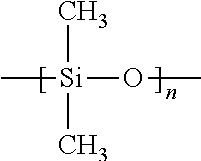Antiperspirant/deodorant composition
a technology of antiperspirant and deodorant, applied in the field of antiperspirant/deodorant composition, can solve the problem of high cost of materials, and achieve the effect of reducing the cost of manufacture of antiperspirant/deodorant compositions
- Summary
- Abstract
- Description
- Claims
- Application Information
AI Technical Summary
Benefits of technology
Problems solved by technology
Method used
Image
Examples
example 1
Prototype Formulation is Illustrated in Table 1
[0075]
TABLE 1IngredientAmount (wt. %)C12-15 Alkyl Benzoate5.9PPG-14 Butyl Ether5.9H-Soybean Oil2Castor Wax MP806.5PEG-8 Distearate3.3Stearyl Alcohol17Behenyl Alcohol0.17Cyclomethicone13.6Palm kernel oil23.3Bentone 27 VCG1Propylene Carbonate0.33Talc17.7Alum2Minors (fragrance, stabilizers, etc.)Q.S.
example 2
Alum Suspension in Antiperspirant / deodorant Formulations (I)
[0076]When manufacturing antiperspirant / deodorant formulations comprising alum, it was observed that in the molten composition, there was a tendency for alum to settle. As a result, once the composition had cooled and hardened into a solid form, there was an uneven distribution of alum through the solid.
[0077]To address this problem, various thickeners and structure enhancers (test materials) were tested to determine whether the suspension of alum could be improved in the presence of these materials. The material was incorporated into a potassium aluminum sulfate (potassium alum)-containing antiperspirant / deodorant base formulation. The components of the formulation, including the test material, were heated to form a molten composition and mixed. After mixing, the molten composition was poured into an inverted dispenser (such that the dispenser cap was at the bottom), and allowed to cool such that a solid stick formed. Afte...
example 3
Alum Suspension in Antiperspirant / deodorant Formulations (II): Talc and Clay
[0082]The procedure described in Example 2 was repeated using a base formulation, comprising 3 weight % potassium alum, 16.7 weight % talc and 1 weight % Bentone® clay (hectorite). The results are illustrated in Table 3.
TABLE 3effects of talc and clay on settling of alum in a base formulationBase with 3 weight % potassiumalum 16.7 weight % talc and1 weight % Bentone ® clayAl target (wt. %)0.31Al range (weight %)0.26-0.36Al at top of stick (weight %)0.27
[0083]It can be seen from Table 3 that in the presence of about 17 weight % talc and 1 weight % clay, alum was effectively suspended such that the amount of aluminum at the top of the stick fell within the target / expected range.
[0084]When a comparable amount of talc was used in the absence of clay, there a visible separation of the molten formulation before pouring into the dispenser suggesting settling of the alum and / or talc.
[0085]When bentone was used in hi...
PUM
| Property | Measurement | Unit |
|---|---|---|
| melting point | aaaaa | aaaaa |
| average molecular weight | aaaaa | aaaaa |
| melting point | aaaaa | aaaaa |
Abstract
Description
Claims
Application Information
 Login to View More
Login to View More - R&D
- Intellectual Property
- Life Sciences
- Materials
- Tech Scout
- Unparalleled Data Quality
- Higher Quality Content
- 60% Fewer Hallucinations
Browse by: Latest US Patents, China's latest patents, Technical Efficacy Thesaurus, Application Domain, Technology Topic, Popular Technical Reports.
© 2025 PatSnap. All rights reserved.Legal|Privacy policy|Modern Slavery Act Transparency Statement|Sitemap|About US| Contact US: help@patsnap.com

